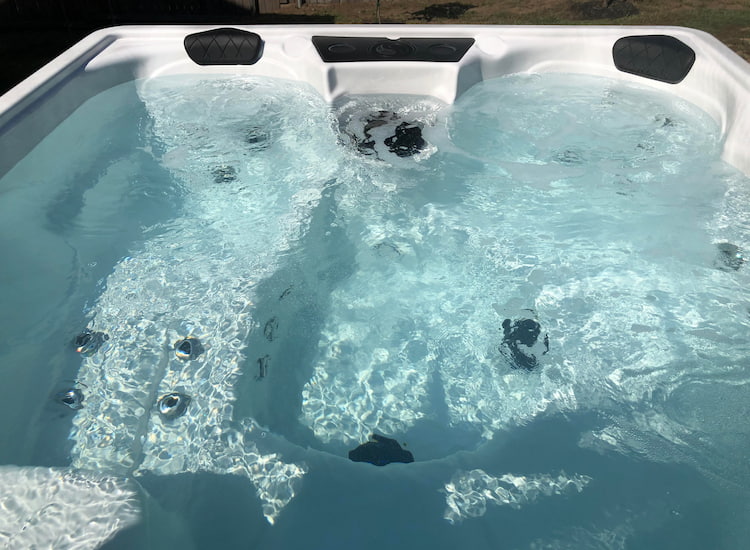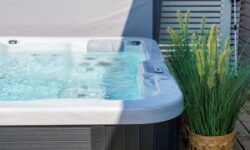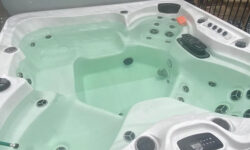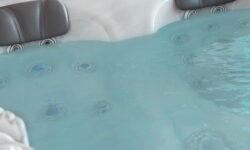You’re staring at your hot tub, puzzled. Should the water be crystal clear, blue, or a different hue? You’re not alone in this conundrum.
Hot tub water should be clear. This is because clear water is usually a good indication that the water is clean and free from any impurities, bacteria, or algae that could potentially cause harm to your health. If the water is cloudy, discolored, or smells bad, it is usually a sign that the water is contaminated and needs to be treated or changed.
Whether you’re a new hot tub owner or a seasoned spa enthusiast, understanding the ideal color of your hot tub water is crucial. It’s not just about aesthetics – it’s about hygiene, too.

Quick Navigation
Understanding the Ideal Color of Hot Tub Water
You’ve got to understand that the ideal color of hot tub water isn’t necessarily what you’d expect. Contrary to popular belief, crystal clear water isn’t always best. Yes, you read that right. In fact, a slight tint or coloration can often indicate a well-balanced hot tub.
Let’s break it down. Ideally, hot tub water should be a light, sparkling blue. This indicates an appropriate balance of sanitizer, like chlorine or bromine, and a correct pH level. The blue tint doesn’t come from any added chemicals but is a reflection of the tub’s interior. Therefore, if your tub is white, the water may appear clearer than in a blue or darker tub.
On the other hand, if your hot tub water is green, brown, or cloudy, those are warning signals. Green water can indicate the presence of algae, while brown water can suggest a problem with your hot tub’s metal components. Cloudy water often points to a filtration issue or a chemical imbalance.
The Significance of Different Hot Tub Water Colors
In the world of hot tub maintenance, you’ll find that different water colors carry significant meanings, and identifying these colors can be crucial in preserving the quality and safety of your hot tub.
The color of your hot tub water can provide a quick diagnostic check on the overall health of your system. To illustrate, let’s look at a simple table:
| Color | Potential Cause | Recommended Action |
|---|---|---|
| Clear | Balanced water | Enjoy your hot tub |
| Green | Algae growth | Shock the water, scrub surfaces |
| Cloudy | High calcium, pH imbalance | Adjust chemical levels |
| Foamy | High contaminant level | Shock the water |
| Brown | Excessive minerals | Use a mineral remover |
Clearly, not all water colors are created equal. Green water could indicate algae growth, which may need a shock treatment and scrubbing. Cloudy water often points to high calcium or pH imbalance, requiring chemical adjustments.
Foamy water suggests high contaminants, calling for a shock treatment. Yellowish water might mean excessive minerals, needing a mineral remover. Understanding these variations will help you maintain a safe, enjoyable hot tub experience.
Unhealthy Hot Tub Water Colors: What They Mean
Let’s dive deeper into understanding what certain unhealthy hot tub water colors mean for your tub’s overall condition. You need to be aware that not all colors are normal or healthy. Some can indicate serious issues that require immediate attention.
- Green Water: This indicates the presence of algae. Algae thrive in warm water and without proper sanitization, your tub can turn into an algae breeding ground. You’ll need to clean and shock your tub to clear it.
- Foamy or Cloudy Water: This could mean you’re dealing with high mineral content, organic matter, or even a lack of sanitizer. Regular testing and balancing are essential here.
- Brown or Reddish Water: This is a sign of high iron or manganese levels. This can occur if you fill your tub with well water. A metal sequestrant can help resolve this issue.
- Yellow or Mustard Water: This indicates a specific type of algae known as mustard algae. It’s resistant to normal levels of chlorine, so you’ll need to shock your tub and thoroughly brush it.
How to Maintain the Desired Hot Tub Water Color
Regularly checking and adjusting the chemical balance of your hot tub is essential to maintaining the desired water color. The ideal color should be clear, indicating that the tub’s pH, alkalinity, and sanitizer levels are properly balanced.

To maintain this balance, you’ll first need to test the water, using either test strips or a liquid test kit. These tools measure the pH, total alkalinity, and sanitizer levels. As a rule of thumb, the pH should be between 7.4 and 7.6, alkalinity between 80 and 120 ppm, and sanitizer levels in line with the manufacturer’s recommendations.
If you find that the chemical levels are off, you’ll need to adjust them. Use hot tub chemicals, such as pH increasers or decreasers, alkalinity up, and sanitizers, to make these adjustments. It’s important to add these chemicals gradually, letting the water circulate for a few hours before retesting and adjusting again if needed.
Regular maintenance, including weekly testing and adjusting, as well as monthly shock treatments, will help keep your hot tub water clear and inviting. Ultimately, your diligence will pay off in a hot tub that’s always ready for you to relax in.
Troubleshooting Color Issues in Your Hot Tub Water
You’ve got your hot tub and you’re maintaining it, but sometimes you might still encounter color issues in your water. Don’t worry, this is a common problem and can usually be resolved with a few steps.
- Check the pH level: Incorrect pH levels can cause water to become cloudy or discolored. Use a test kit to ensure your water’s pH is between 7.2 and 7.8.
- Inspect the filter: A dirty or damaged filter can cause water discoloration. Regularly clean your tub’s filter to maintain clear water.
- Look for metals: High levels of metals like iron can turn your water green or brown. Use a metal sequester to bind the metals and prevent discoloration.
- Shock the water: If all else fails, shocking your tub with a high level of sanitizer can eliminate bacteria and other impurities causing color issues.
Frequently Asked Questions
You’d typically use chlorine or bromine to sanitize your hot tub water. These chemicals don’t directly maintain the color but ensure it stays clear by killing bacteria and other impurities.
No, the color of your hot tub cover doesn’t affect the water’s color. It’s primarily for insulation and protection. The water color depends on cleanliness, chemical balance, and any lighting you may have installed.
You should test your hot tub water at least twice a week. Regular testing ensures the water’s clarity and safety by maintaining the right balance of chemicals. It’s crucial for your tub’s longevity and your health.
If you’re considering using a hot tub with off-colored water, it’s not recommended. Discolored water could indicate chemical imbalance or contamination, which isn’t safe for bathing. Always ensure clear, balanced water before entering.
Yes, certain health conditions can be worsened by improperly treated hot tub water. If it’s green, black, or cloudy, harmful bacteria could be present, potentially aggravating skin conditions or respiratory issues.
Conclusion
In conclusion, your hot tub water should always be clear and odorless. Any change in color indicates an issue, from algae growth to mineral buildup. Regular maintenance, including testing and adjusting chemicals, can keep your water pristine.
If you’re facing persistent color issues, professional help may be your best bet. Remember, the clarity of your hot tub water is not just about aesthetics, but about your health and safety too.

![Is Yellow Hot Tub Water Safe? [& Treatment Options] is yellow water in hot tub safe](https://hottubtales.com/wp-content/uploads/2023/10/is-yellow-water-in-hot-tub-safe-250x150.jpg)




![How Many Gallons of Water in a Hot Tub? [Different Sized Hot Tubs] how many gallons of water in a hot tub](https://hottubtales.com/wp-content/uploads/2023/10/how-many-gallons-of-water-in-a-hot-tub.jpg)